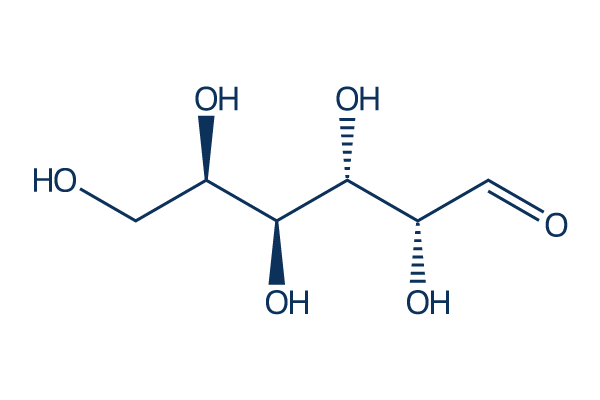|
受注:045-509-1970 |
技術サポート:tech@selleck.co.jp 平日9:00〜18:00 1営業日以内にご連絡を差し上げます |
化学情報

|
Synonyms | D-Galactopyranose, D-(+)-Galactose | Storage (From the date of receipt) |
3 years -20°C powder 1 years -80°C in solvent |
|||
| 化学式 | C6H12O6 |
||||||
| 分子量 | 180.16 | CAS No. | 59-23-4 | ||||
| Solubility (25°C)* | 体外 | DMSO | 36 mg/mL (199.82 mM) | ||||
| Water | 36 mg/mL (199.82 mM) | ||||||
| Ethanol | Insoluble | ||||||
| 体内 (毎回新しく調製した物を用意してください) |
|
||||||
|
* <1 mg/ml means slightly soluble or insoluble. * Please note that Selleck tests the solubility of all compounds in-house, and the actual solubility may differ slightly from published values. This is normal and is due to slight batch-to-batch variations. |
|||||||
溶剤液(一定の濃度)を調合する
生物活性
| 製品説明 | D-Galactose (D-Galactopyranose, D-(+)-Galactose) is an aldohexose that occurs naturally in the D-form in lactose, cerebrosides, gangliosides, and mucoproteins and is converted enzymatically into D-glucose for metabolism or polysaccharides for storage. It accelerates senescence in invertebrates and mammals and has been used as a model for aging.D-Galactose can be used to induce animal models of Senescence. |
|---|---|
| in vitro | D-Galactose (D-gal) can induce oxidative stress in non-cancer cells and result in cell damage by disturbing glucose metabolism. This compound can transcriptionally up-regulate the genes relevant to necroptosis (Bmf, Bnip3) and autophagy (Atg5, TIGAR) but not the genes related to apoptosis (Caspase3, Bax, and p53). It does not activate Caspase-3, but prompts puncta-like GFP–LC3 distribution, an indicator for activated autophagy[1]. |
プロトコル(参考用のみ)
| 細胞アッセイ | 細胞株 | Mouse neuroblastoma cell line Neuro2a (N2a), human neuroblastoma cell line SH-SY5Y, human prostate cancer cell line PC-3 and mouse fibroblast cell line NIH3T3; Human hepatoma cell line HepG2 and human hepatocyte cell line LO2 |
|---|---|---|
| 濃度 | 0-60 g/L | |
| 反応時間 | 24 h | |
| 実験の流れ | Mouse neuroblastoma cell line Neuro2a (N2a), human neuroblastoma cell line SH-SY5Y, human prostate cancer cell line PC-3 and mouse fibroblast cell line NIH3T3 are cultured in DMEM supplemented with 10% FBS, 100 U/ml penicillin, and 100 mg/ml streptomycin. Human hepatoma cell line HepG2 and human hepatocyte cell line LO2 are cultured in RPMI 1640 with 10% FBS. Cells are maintained at 37℃ with 5% CO2, and treated with D-gal or glucose in the concentrations and the time periods. Morphological assessments are conducted under microscope. Cell viability is evaluated by MTT assay. |
参考
|
Selleckの高級品が、幾つかの出版された研究調査結果(以下を含む)で使われた:
| Downregulated TFPI2 Accelerates Skin Aging by Repressing the Cell Cycle through Phosphoinositide 3-Kinase/Protein Kinase B/CDC6 Pathway [ J Invest Dermatol, 2025, S0022-202X(25)00033-8] | PubMed: 39848565 |
| BRD4 plays an antiaging role in the senescence of renal tubular epithelial cells [ Transl Androl Urol, 2024, 13(6):1014-1023] | PubMed: 38983468 |
| Iron derived from NCOA4-mediated ferritinophagy causes cellular senescence via the cGAS-STING pathway [ Cell Death Discov, 2023, 10.1038/s41420-023-01712-7] | PubMed: 37980349 |
| Hypoxia-dependent expression of MAP17 coordinates the Warburg effect to tumor growth in hepatocellular carcinoma [ J Exp Clin Cancer Res, 2021, 40(1):121] | PubMed: 33832535 |
| CD73 is a hypoxia-responsive gene and promotes the Warburg effect of human gastric cancer cells dependent on its enzyme activity [ J Cancer, 2021, 12(21):6372-6382] | PubMed: 34659527 |
| Single-cell transcriptome analysis reveals differential nutrient absorption functions in human intestine. [ J Exp Med, 2020, 217(2)] | PubMed: 31753849 |
長期の保管のために-20°Cの下で製品を保ってください。
人間や獣医の診断であるか治療的な使用のためにでない。
各々の製品のための特定の保管と取扱い情報は、製品データシートの上で示されます。大部分のSelleck製品は、推薦された状況の下で安定です。製品は、推薦された保管温度と異なる温度で、時々出荷されます。長期の保管のために必要とされてそれと異なる温度で、多くの製品は、短期もので安定です。品質を維持するが、夜通しの積荷のために最も経済的な貯蔵状況を用いてあなたの送料を保存する状況の下に、製品が出荷されることを、我々は確実とします。製品の受領と同時に、製品データシートの上で貯蔵推薦に従ってください。
